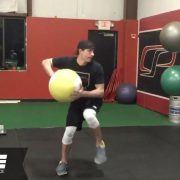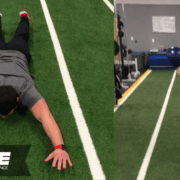How to Prepare in the On-Deck Circle
Baseball players have been swinging weighted implements in the on-deck circle for what seems like forever.
Weighted “donuts,” bat wraps, and heavy bats weighing up to 80 oz. are all fixtures at ballparks from the youth level up to the Major Leagues, and many hitters feel that swinging these weighted implements give them a performance boost by increasing their swing speed in the batter’s box.
However, an in-depth look at the research surrounding these tools shows that most of them might have no effect, or even a negative effect on performance, and lends credence to the idea that there might be a better way to warm up before hitting.
Here’s how some common on-deck tools stack up against each other, and a look at a relatively new strategy for warming up that current research suggests might be better than what we’ve all been doing for decades.
Bat Weights
Bat weights are, historically, the most common on-deck warmup tool that players use to prepare for hitting. These typically weigh 16-24 ounces, and can be applied to the bat either around the barrel or closer to the handle, depending on the brand.
Many baseball and softball players opt to use bat weights while taking practice swings in the on-deck circle because their swing feels faster after they remove the weight and start taking normal swings.
While there is something to be said for the psychological confidence boost one gets from feeling like their swing speed is increased, research shows that swing speeds typically DECREASE as compared to baseline after swinging with a weight on the bat.
So, while bat weights may provide a psychological benefit, they provide no physical benefit and may have a detrimental effect on swing speed when used directly before an at-bat.
Another (possibly bigger) issue with bat weights is that they alter the center of mass (COM) of the bat, which can disrupt swing timing and swing mechanics.
Hitting a baseball requires a high level of precision during the swinging motion, which can be thrown off by adding and/or removing weight at any point along the length of the bat, affecting its weight distribution.
This is especially true for younger athletes who have not yet established the level of motor patterning required to produce a highly consistent swinging motion.
Research has shown that hitters are less likely to produce consistent contact with the sweet spot of the bat immediately after warming up with a weighted implement, likely due to the slightly altered swing mechanics caused by the change in the bat’s COM.
While swing mechanics are eventually restored to normal after several swings with a normally-weighted bat, it can take up to 10 swings before normal kinematics are achieved.
Since most at-bats end with the batter taking far fewer than 10 swings, it’s generally not advisable to try to hit immediately after swinging with a weighted implement.
Imagine playing darts by warming up with a dart that has a small weight attached to the end of it, and then trying to throw a normal dart immediately afterwards.
Your throws right after switching to a normal dart would likely be erratic at best, and it would take a few throws for your body to “remember” how to throw the normally-weighted dart. This same principle applies for swinging a baseball bat, and in a sport where precision is so important, it’s likely not a good idea to utilize bat weights while warming up.
Heavy Bats
Heavy bats have recently seen an uptick in popularity as both a training aid, and as a warmup aid for use in the on-deck circle.
Most of these heavy bats are designed to mimic the weight distribution of a regular bat, which likely makes them a better warm-up option than bat weights since they have a center of mass that is like a normal bat, and will therefore cause less of a disturbance in swing mechanics after switching to a normal bat.
However, research has shown that warming up with a weighted bat can cause a decrease in swing speed after switching to a normal bat, so while they are potentially less detrimental than bat weights, there still isn’t much of a benefit.
Bats with heavily weighted knobs have also become popular recently, and have been touted to help hitters “keep their hands inside the ball.”
While it may be true that concentrating most the bat’s weight in the handle will prevent hitters’ hands from drifting away from their body or “casting” while they swing it, there is currently no research suggesting that these bats are helpful as a warm-up implement.
Again, the vastly different COM and weight distribution of these bats as compared to a normal bat will likely have a negative effect on swing mechanics after switching back to a normal bat.
Underweighted Bats
Underweighted bats, like heavy bats, are being used more as training aids to develop bat speed, and have shown some promise as a part of the warm-up process.
Using an underweighted bat as a warm-up implement generally has been shown to have either a positive effect on swing speed, or no significant effect, depending on which study you’re looking at.
At the very least, they seem to not have any negative effect on swing speed. However, it’s still possible that the underweighted bat may have a slightly different weight distribution than a player’s normal bat, so there is a chance that swing mechanics could be altered as a result of using it to warm up.
Normal Bats
While they may not be a cool or flashy option as a warm-up implement, there’s a good amount of research that suggests that just taking hard swings with a normal baseball bat may be the most beneficial warm-up a hitter can do in the on-deck circle.
Studies have shown similar improvements in swing speed following warm-up swings with a normal bat as compared to an underweighted bat, and there’s no chance of altered swing mechanics due to differences in COM or weight distribution.
In fact, the most effective way of warming up before hitting might be to utilize a normal bat, along with a max-effort isometric exercise designed to induce a phenomenon called Post-Activation Potentiation.
Using Post-Activation Potentiation to Increase Swing Speed
Post-Activation Potentiation or PAP is, admittedly, not well-understood by researchers just yet. Without getting deep into the proposed biological mechanisms of how PAP works, the basic idea behind this theory is that a high-intensity exercise can “supercharge” your body to move more explosively after an appropriate rest interval.
For example, it’s widely reported that sprinter Ben Johnson used to perform max effort squats before running races, and it provided him with a bit more explosiveness while running.
In general, it’s best to try to elicit PAP for a specific movement by stressing the muscles involved in that movement. For example, vertical jump height can be increased by doing heavy squats, explosive pushup velocity can be increased by performing a heavy bench press, etc.
So, if you’re looking to improve swing speed through post-activation potentiation, you’ll likely want to perform a movement that mimics a baseball swing. The best way to do this is to attach a bat handle or a rope handle to a chain, and then anchor that chain to an unmovable object like a wall or a fence post.
Stand far enough away from the wall that you can put yourself into the “slot” position as shown in the video below, and then focus on rotating as hard as you can, as if you’re trying to pull the chain completely out of the wall.
To elicit PAP, perform 3 repetitions of this isometric exercise for 3-5 seconds each. Studies have shown that performing these isometric “simulated swings” can increase swing speed by an average of 2 mph. For reference, an increase in bat speed of 2 mph will make a batted ball travel 8-16 feet farther, which could very well be the difference between an out or a homerun.
Timing of PAP
While PAP can be an extremely useful method for improving performance, it does come with a caveat. That is, it only works if you can recover from the high-intensity exercise before attempting an explosive movement.
For that reason, it’s best to perform isometric swings at least 1-2 minutes prior to an at-bat. Studies show that the greatest effects of PAP are seen between 2-12 minutes after performing a high-intensity exercise, and that less than 2 minutes of recovery can cause a decrease in explosiveness.
Given this information, it would make sense to perform max effort isometric swings either while “in the hole” or during the inning prior to an at-bat. This will give your body enough time to recover from the max-effort exercise and still experience an increase in rotational explosiveness.
Then when you step into the on-deck circle to warm-up to hit, take 5-8 max-effort swings with your normal bat, time the pitcher’s delivery, and then step up to the plate to hit. Your swing will be faster because of PAP, and you’ll have a higher likelihood of making consistent contact due to your warmup swings being performed with the same bat you’ll use during your at-bat.
Sources:
Montoya, B.S., Brown, L.E., Coburn, J.W., & Zinder, S.M. (2009). Effect of Warm-up With Different Weighted Bats on Normal Baseball Bat Velocity. Journal of Strength and Conditioning Research, 23(5), 1566-1569.
Szymanski, D.J., Beiser, E.J., Bassett, K.E., Till, M.E., Medlin, G.l., & DeRenne, C. (2011). Effect of Various Warm-Up Devices on Bat Swing Velocity of Intercollegiate Baseball Players. Journal of Strength & Conditioning Research, 25(2), 287-292.
Higuchi, T., Nagami, T., Mizuguchi, N., & Anderson, T. (2013). The Acute and Chronic Effects of Isometric Contraction Conditioning on Baseball Bat Velocity. Journal of Strength and Conditioning Research, 27(1), 216-222.
Gilmore, S.L. (2013), Effect of a High-Intensity Isometric Potentiating Warm-up on Bat Velocity. WWU Masters Thesis Collection. 299.
Andrew Sacks
Latest posts by Andrew Sacks (see all)
- How to Prepare in the On-Deck Circle - May 8, 2018
- 5 Drills to Stay Healthy During Baseball Season - February 21, 2017













Thank you so much for sharing this useful article.This is very useful for all people who don’t know about it.if you are interested in Summer Training on Mean Stack 2019
Join Mean Stack Certification Course.
Keith Hernandez just commented during a Mets-Cards game that taking a knee from on deck circle gave him the best angle to view a pitcher’s stuff. And that timing his stride vs. a full swing worked better for him. As a HS player I swung weighted bats way too often. A spine MRI 50 years later showed some damage, likely a slight fracture long ago from repetitive use that flared up from lifting furniture.